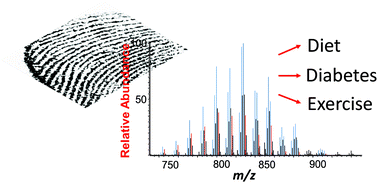Potential of triacylglycerol profiles in latent fingerprints to reveal individual diet, exercise, or health information for forensic evidence†
Abstract
Triacylglycerols (TGs) are a primary component of human skin oils and are therefore a major constituent present in latent fingerprint residue. We hypothesize that differences in the TG profile of the latent fingerprint, such as the relative level of saturation of the fatty acyl chains, may link back to the overall health of the subject, specifically correlated to diabetes. A small scale proof-of-concept study was performed to test this hypothesis. The biggest differences observed were in the relative amounts of completely saturated TGs compared to TGs with one or more double bonds; however, hierarchical clustering could not differentiate diabetic and non-diabetic participants. The role of other factors such as diet and exercise was explored from subsets of the non-diabetic participants. Vegetarian participants had higher relative levels of saturated TGs compared to those without diet restrictions; however, people on a low carbohydrate or ketogenic diet were not distinguishable from the control population. In terms of exercise, male participants who were very active had lower levels of saturated TGs compared to males who did not exercise at all. In contrast, exercise did not have much of an effect on the TG profile of female participants. While the outcome of this study is only tentative due to the lack of statistical power, it suggests the potential of TG profiles to be linked to health information, diet and exercise.



 Please wait while we load your content...
Please wait while we load your content...